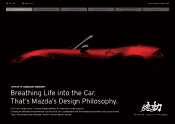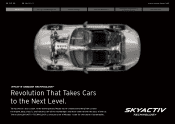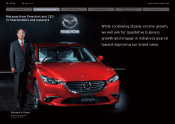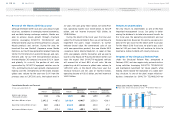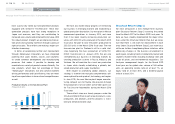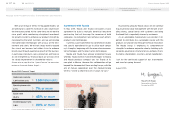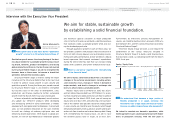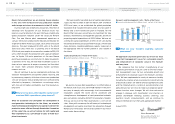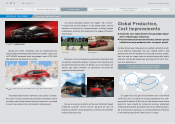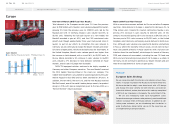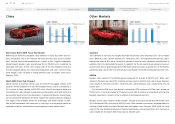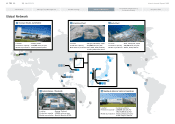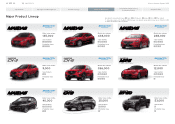Mazda 2015 Annual Report Download - page 13
Download and view the complete annual report
Please find page 13 of the 2015 Mazda annual report below. You can navigate through the pages in the report by either clicking on the pages listed below, or by using the keyword search tool below to find specific information within the annual report.
Introduce five models—four new models and one deriva-
tive model—that offer driving pleasure and outstanding
environmental and safety performance
Realize optimal common architecture through global
integrated planning that encompasses development,
manufacturing, and sourcing
Since launching the Mazda CX-5 in 2012, we have been expand-
ing our lineup of SKYACTIV products, and going forward
we will pursue continuous evolution in SKYACTIV products
through coherent technological advancements and evolution
of KODO design.
For example, in January 2015 we began rolling out updated
versions of the Mazda6 (Japanese name: Mazda Atenza) and
CX-5. In addition to updated interior and exterior designs and
enhanced driving performance, these models incorporate our
latest advanced technologies, such as Mazda Connect and new
safety features. We will add these features as appropriate to
other models as well, to always provide customers with the
most up-to-date design, technology, and features.
Moreover, during the period covered by Structural Reform
Stage 2, we plan to introduce five models—four new models and
one derivative model—that deliver driving pleasure and out-
standing environmental and safety performance. Our aim is to
achieve steady growth in sales volume through the continuous
evolution of SKYACTIV products and new model launches.
We will also pursue technological development for next-
generation products with an emphasis on the environment
and safety, including compliance with increasingly strict envi-
ronmental regulations around the world.
In terms of environmental technologies, we anticipate that
for the time being, most automobiles will continue to be pow-
ered by internal-combustion engines, including hybrids. Mazda
has made significant strides in improving internal-combustion
engines to date and going forward we will work to make fur-
ther advances in internal-combustion engines by realizing
ultimate combustion technology. We will also aim for major
improvements in fuel efficiency by adding electric devices.
The average fuel economy of Mazda cars being sold in 2015
on a global basis approximately 30% higher than the figure for
2008, and we plan to raise this margin of improvement to
50% by 2020.
With regard to safety technologies, we are conducting
research and development based on the concept of Mazda
Proactive Safety, which provides person- and driver-focused
safety and security. We will pursue steady advances in such
technologies as next-generation Human Machine Interface
(HMI) and i-ACTIVSENSE, Mazda’s most advanced safety tech-
nology, which uses detection devices.
Reinforce sales with a full lineup of SKYACTIV products
Drive reforms at the sales frontline to instill sales
strategy that enhances brand value
Mazda is successively rolling out SKYACTIV-equipped models in
segments including SUVs, sports cars, mid-size sedans, hatch-
backs, and compact cars. Our plan is for at least 85% of cars
sold in the March 2016 fiscal year to be SKYACTIV-equipped
models, and we intend to leverage this full lineup of SKYACTIV
products to strengthen sales.
We will continue to make advances in SKYACTIV products
and always feature models that incorporate the latest designs
and technologies in showrooms, offering Mazda vehicles that
meet increasingly diversified customer needs. Given the strong
sales of models such as the CX-5 and Mazda CX-3, we will
increase our focus on crossover-type models going forward, as
we expect demand in this segment to continue to grow globally.
Average fuel economy for all cars
2008 2015 2020
Drastically improve fuel
economy by combining ultimate
combustion and electrification
technology
Plan to raise average
fuel economy globally
Approx.
30%
Plan to raise average
fuel economy globally
Approx.
50%
GEN1
GEN2
Product and R&D
Strengthening Global
Sales and Networks
• More refined design expression
• Dynamic performance with enhanced quality and comfort
• Significantly improved interior design and quality feel
• Latest features
Mazda Connect Adaptive LED
headlight
Electric parking
brake
Updated Mazda6 and CX-5
Improving the Fuel Economy of Mazda Vehicles 50% by 2020 (vs. 2008)
Structural Reform Stage 2
SPECIAL FEATURE
Mazda Annual Report 2015
11
Growth Strategy
CONTENTS
Foundations Underpinning
Sustainable Growth
oduction
Review of Operations
Corporate Data
Message from Management


